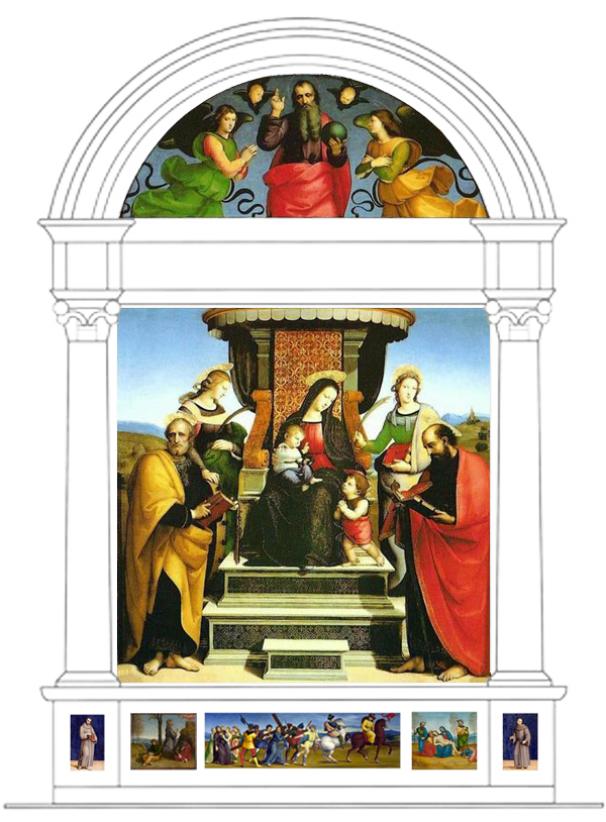Raffaello (1483-1520)
Pietà
c.1503–1505
Oil on poplar panel, 23.6 x 28.8 cm
Isabella Stewart Gardner Museum, Boston
This panel was originally part of the base (predella) of the Colonna Altarpiece (Pala Colonna).
Not satisfied with a single Raphael painting, Isabella Stewart Gardner waited just two years before purchasing her second work by the artist. This small panel, exquisitely preserved with luminous colors, was painted as part of a narrative predella, or lower register of an altarpiece, for a convent of Franciscan nuns in Perugia, Italy. In the early seventeenth century, the predella was separated from the rest of the altarpiece, and both parts began their journey through the art world. Gardner acquired her fragment in 1900, while J.P. Morgan purchased largest part of the same altarpiece one year later. She set this painting on a table, with a chair positioned as if to allow close, personal contemplation of the picture. She arranged the display perpendicular to the window, to catch daylight for viewing.
In this small panel Raphael created an arrangement of varied pose and color, and the figures exhibit his trademark sweetness of emotion. Before a somewhat realistic landscape (as opposed to the flat, gold ground of earlier religious paintings), Saint John and the Virgin Mary tenderly support the dead Christ. Joseph of Arimathea and Nicodemus, who brought Christ down from the cross, frame the group, and Mary Magdalene kneels to kiss Christ’s foot.
The painting originally formed part of the lower section (predella) of a large altarpiece with scenes from the life of Christ, which Raphael painted for a convent in Perugia. Isabella Gardner set this painting on a table, with a chair positioned as if to allow close, personal contemplation of the picture. She arranged the display perpendicular to the window, to catch daylight for viewing. (ISGM)
Raphael painted this altarpiece around 1504/5 for the Franciscan convent of Sant’Antonio in Perugia. It hung in a part of the church reserved for the nuns, who may have insisted on its conservative details, such as the elaborately clothed Christ. By contrast, the weighty male saints reflect the progressive style developed by Leonardo da Vinci and Fra Bartolomeo that Raphael had just begun to study in Florence. The lunette above the main panel depicts God the Father holding a globe and delivering a blessing between two angels and two seraphim. (MET)
The Colonna Altarpiece
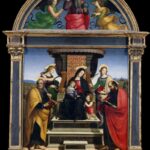 Raffaello (1483-1520)
Raffaello (1483-1520)
Pala Colonna
c.1504–1505
Metropolitan Museum of Art, New York
Main panel:
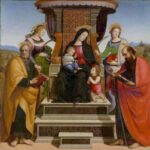 Raffaello (1483-1520)
Raffaello (1483-1520)
Madonna in trono con santi
c.1504–1505
Metropolitan Museum of Art, New York
Predella:
 Raffaello (1483-1520)
Raffaello (1483-1520)
San Francesco d’Assisi
c.1502
Dulwich Picture Gallery, London
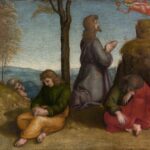 Raffaello (1483-1520)
Raffaello (1483-1520)
L’orazione nell’Orto
c.1504
Metropolitan Museum of Art, New York
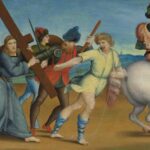 Raffaello (1483-1520)
Raffaello (1483-1520)
Processione al Calvario
c.1504–1505
National Gallery, London
 Raffaello (1483-1520)
Raffaello (1483-1520)
Sant’Antonio da Padova
c.1502
Dulwich Picture Gallery, London
Reconstruction of the Colonna Altarpiece:
Reconstruction of the Colonna Altarpiece: top and center: Madonna in trono con santi (Metropolitan Museum of Art, New York); bottom, left to right: San Francesco d’Assisi (Dulwich Picture Gallery, London), L’orazione nell’Orto (Metropolitan Museum of Art, New York), Processione al Calvario (National Gallery, London), Pietà (Isabella Stewart Gardner Museum, Boston), Sant’Antonio da Padova (Dulwich Picture Gallery, London).

